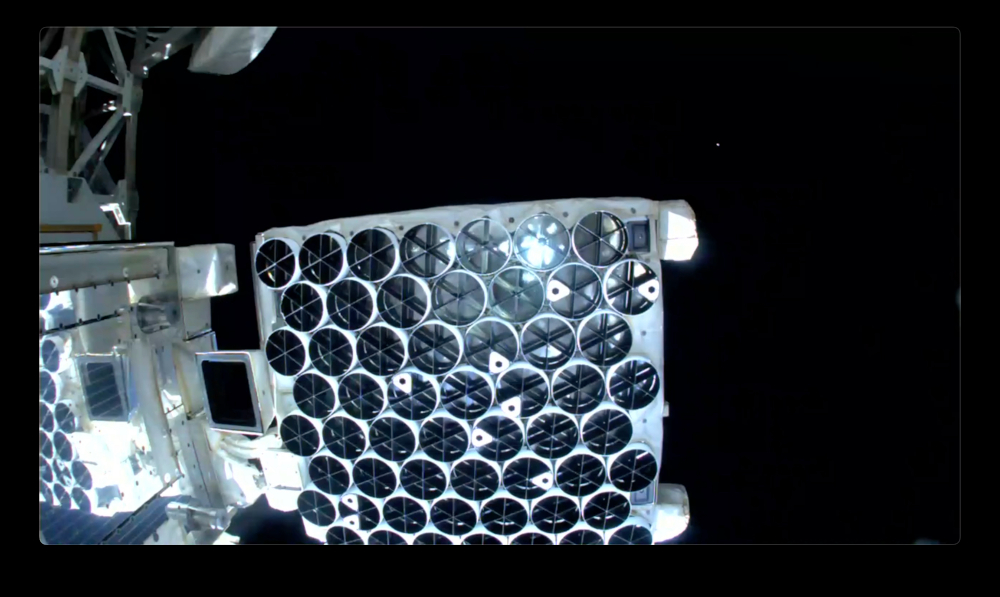January 24, 2025: Update on EVA 91On January 16, during EVA 91, International Space Station crew-member Nick Hague performed a spacewalk during which he installed nine patches to cover areas of NICER's thermal shields -- filters that block visible and infrared light -- damaged in May 2023. The task was accomplished quickly and flawlessly, and we have verified that its immediate objective was achieved: NICER data show that the detectors behind the patched optics are receiving lower levels of focused light during orbit night, and the overall level of light inside the instrument during orbit day is substantially reduced. NICER is in better shape than it has been since May 2023. 
NICER, after patching, reflected in the visor of ISS astronaut Nick Hague's helmet. Zoom in to see the patches that were installed. It is now clear, however, that the instrument is still sensitive to daylight -- less than before but more than expected. The installed patches were not a complete solution to the "light leak" problem, which suggests that the full extent of thermal-shield damage was not discernible given the information (astronomical observations and photos obtained from a distance) available before the spacewalk. By eliminating the major light leaks from the obvious holes, the newly installed patches -- together with close-up photos obtained by Nick -- are enabling collection of valuable new information and providing a path toward more effective mitigation of the remaining light-leak effects. We are working hard to assess and implement such mitigations through adjustments to the instrument's configuration, to regain as much orbit-day science productivity as possible. We will communicate our progress on the NICER HEASARC homepage and through follow-up messages to this list. In the meantime, NICER continues to operate with its full measurement capabilities during orbit night, enabling further trailblazing time-domain and multimessenger astrophysics. NICER data acquired since May 2023 have appeared in 42 peer-reviewed published papers (including one in Nature, with another currently submitted) as well as 22 AstronomerŐs Telegrams. The NICER team is immensely grateful to the entire ISS program for their cooperation, enthusiasm, and brilliant execution of the spacewalk to service NICER. January 26, 2024: Update on Patching of the NICER Light LeakOn January 9, 2024, NICER received approval from ISS program management to proceed with a light-leak repair effort. The NICER team is targeting launch of a patch kit to ISS in early August 2024, with installation of the patches possibly by the end of August, or in Fall 2024. X-ray data from a variety of celetial sources strongly suggest that the damage is limited to some of the thin optical-blocking/thermal filters that cover NICER's X-ray Concentrator (XRC) optics. Imagery from ISS cameras and crew reveals that several of the thin films are affected, with damage ranging from small pinholes to one large tear. These openings allow visible and infrared light to flood the interior of the X-ray Timing Instrument's (XTI) optical bench during ISS orbit day. Orbit-night observations are unaffected. 
The repair effort involves placing pie-shaped patches into certain XRC sunshade sectors. These patches will prevent light from entering the pinholes in those sectors. The patches will latch in place and remain permanently on NICER. At this time, the NICER team expects that as many as five patches will be installed, resulting in a significant reduction of optical loading while only reducing NICER's effective X-ray collecting area by less than 2%. 
Two alternative repair paths are under consideration. One path is to install the patches using ISS robotics systems (EVR), while the other path is for astronauts to install them as an Extra Vehicular Activity (EVA) task. By the end of February, the primary repair path will be selected based on testing and additional detailed analysis by the NICER and ISS teams. 

|

